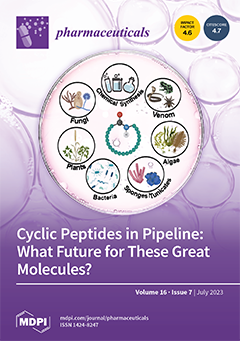The 1,3,4-oxadiazole derivatives
Ox-6a-f have been synthesized by incorporating flurbiprofen moiety with the aim to explore the potential of target molecules to decrease the oxidative stress. The title compounds
Ox-6a-f were prepared by simple reactions in which a flurbiprofen –COOH group was esterified with methanol in an acid-catalyzed medium, which was then reacted with hydrazine to afford the corresponding hydrazide. The acid hydrazide was then cyclized into 1,3,4-oxadiazole-2-thiol by reacting with CS
2 in the presence of KOH. The title compounds
Ox-6a-f were synthesized by the reaction of an –SH group with various alkyl/aryl chlorides, which involves an
S-alkylation reaction. The structures of the synthesized
Ox-6a-f derivatives were ascertained by spectroscopic data. The in silico molecular docking was performed against target proteins cyclooxygenase-2 COX-2 (PDBID 5KIR) and cyclooxygenase-1 COX-1 (PDBID 6Y3C) to determine the binding affinity of the synthesized compounds with these structures. It has been inferred that most of the synthesized compounds bind well with an active binding site of 5KIR compared to 6Y3C, and especially compound
Ox-6f showed excellent binding affinity (7.70 kcal/mol) among all synthesized compounds
Ox-6a-f. The molecular dynamic (MD) simulation has also been performed to check the stability of docking complexes of ligands with COX-2 by determining their root mean square deviation and root mean square fluctuation. Little fluctuation was observed in case of
Ox-6f, which forms the most stable complex with COX-2. The comprehensive antioxidant potential of the synthesized compounds has been evaluated by determining their free radical scavenging activity, including DPPH, OH, nitric oxide (NO), and iron chelation assay. The derivative
Ox-6f showed promising results with 80.23% radical scavenging potential at a dose of 100 µg/mL while ascorbic acid exhibited 87.72% inhibition at the same dose. The anti-inflammatory activity of the final products has also been performed, and inflammatory markers were assayed, such as a thiobarbituric acid-reducing substance, nitric oxide, interleukin-6 (IL-6), and COX-2. The derivatives
Ox-6d and
Ox-6f displayed higher anti-inflammatory activity, exhibiting 70.56% and 74.16% activity, respectively. The results were compared with standard ibuprofen, which showed 84.31% activity at the same dose, 200 µg/mL. The anti-inflammatory potential has been performed by following the carrageen-induced hind paw edema model, and results showed that derivative
Ox-6f exhibited 79.83% reduction in edema volume compared to standard ibuprofen, which reduced 84.31% edema volume. As dry lab and wet lab results confirm each other, it has been deduced that derivative
Ox-6f may serve as the lead structure to design potent compounds to address oxidative stress.
Full article






